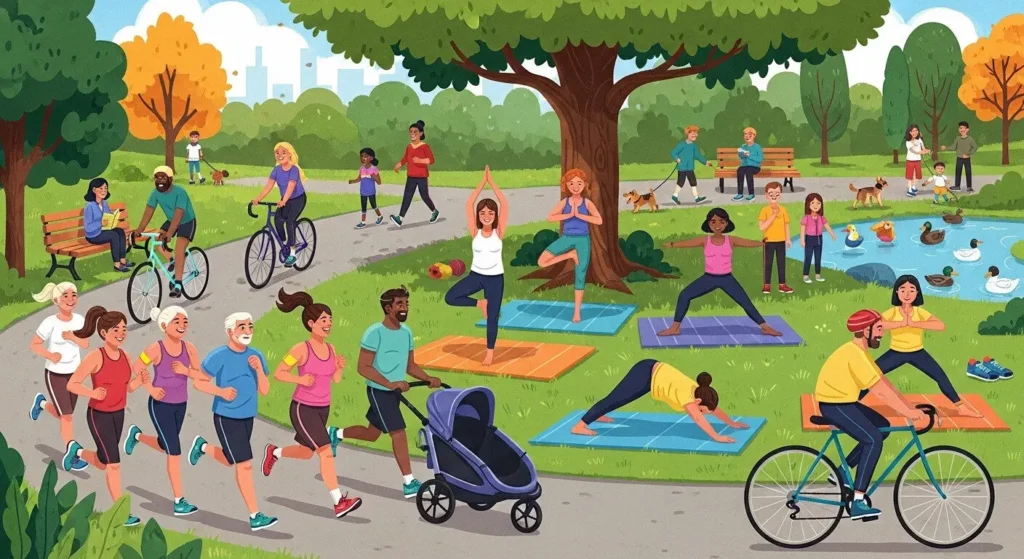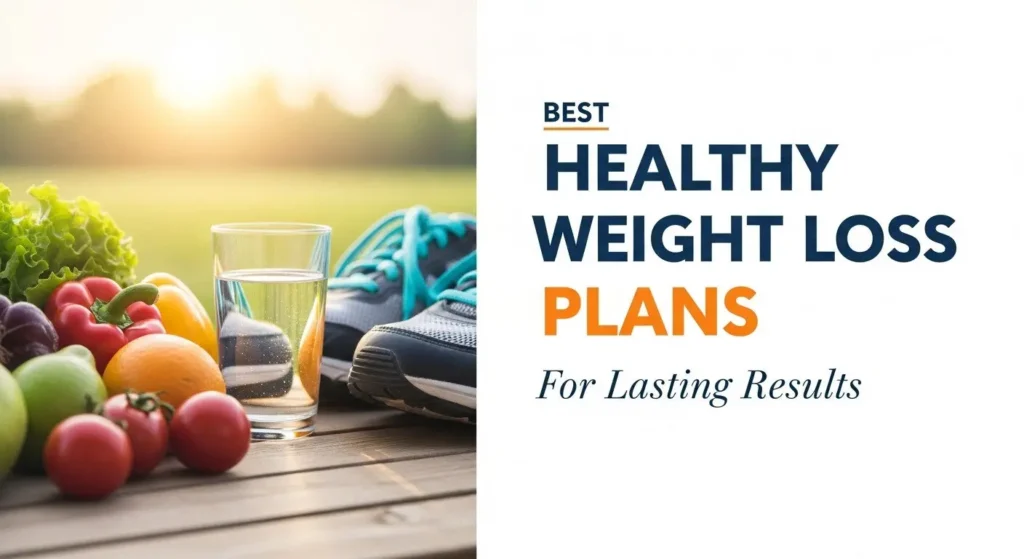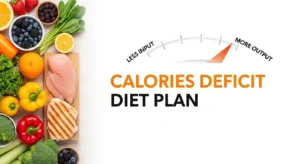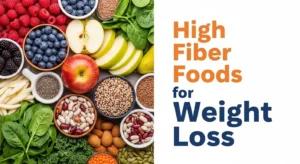Losing weight is a popular topic, with so much information out there telling you what to do (and what not to do!). Healthy weight loss plans aren’t about quick fixes or harsh diets; they focus on smart, lasting changes that help your body feel its best, inside and out.

This article will guide you through creating a personal, healthy weight loss plan that truly works for you, focusing on sustainable habits rather than temporary solutions. Get ready to discover how to reach your goals and keep the weight off for good, all while boosting your energy and overall well-being.
Key Takeaways
- Focus on Sustainable Habits: Healthy weight loss plans are about making small, consistent changes to your daily life, not crash diets or quick fixes.
- Balance Your Plate: Prioritize whole foods like fruits, veggies, lean proteins, and whole grains. Portion control and mindful eating are key.
- Move Your Body Regularly: Find physical activities you enjoy and make them a regular part of your week, combining cardio and strength training.
- Prioritize Sleep & Manage Stress: Good sleep and stress reduction are crucial for your hormones and hunger signals, impacting your weight loss journey.
- Seek Support & Be Patient: Healthy weight loss plans are a journey, not a race. Celebrate small wins, learn from setbacks, and don't hesitate to ask for help from professionals or loved ones.
Understanding Healthy Weight Loss Plans: More Than Just Numbers
When we talk about “healthy weight loss plans,” we're not just talking about the number on the scale. We're talking about improving your overall health, energy, and how you feel every day. It's a journey that builds good habits, not just drops pounds.
What Healthy Weight Loss Plans are (and aren't)
Healthy weight loss plans ARE:
- Gradual and Steady: Aim for 1-2 pounds (about 0.5-1 kg) per week. This allows your body to adjust and helps you keep the weight off.
- Sustainable: It involves changes you can stick with for a long time, even for life.
- Nutrient-Focused: You eat foods that give your body the vitamins, minerals, and energy it needs.
- Holistic: It considers your physical activity, sleep, stress, and mental well-being.
- Empowering: You learn to understand your body and make choices that support your health.
Healthy weight loss plans ARE NOT:
- Crash Dieting: Severely cutting calories or food groups often leads to nutrient deficiencies, muscle loss, and quickly regaining weight (the “yo-yo” effect). 🎢
- Quick Fixes: Pills, extreme cleanses, or magic potions rarely work in the long run and can be harmful.
- Deprivation: Feeling constantly hungry or miserable isn't sustainable or healthy.
- Ignoring Your Body: Pushing yourself too hard with exercise or ignoring hunger/fullness cues.
Why It Matters: Beyond the Scale
Losing weight in a healthy way brings a ton of benefits that go far beyond how you look:
- Improved Energy Levels: Eating better and moving more gives you more get-up-and-go!
- Better Mood: Regular exercise and balanced nutrition can boost your mood and reduce feelings of stress.
- Reduced Health Risks: Lowering your weight can significantly cut your risk for heart disease, type 2 diabetes, high blood pressure, and certain cancers.
- Better Sleep: Healthy habits often lead to deeper, more restful sleep.
- Increased Confidence: Feeling good in your body can boost your self-esteem.
- Greater Mobility: Moving around becomes easier and more comfortable.
Setting Realistic Goals: The SMART Way
Before you start, it's super important to set goals that are realistic and achievable. Think SMART:
- Specific: Instead of “I want to lose weight,” try “I want to lose 10 pounds.”
- Measurable: How will you track your progress? (e.g., scale, measurements, how clothes fit).
- Achievable: Is your goal realistic for your body and lifestyle?
- Relevant: Why is this goal important to you? What impact will it have?
- Time-bound: Set a reasonable timeframe. “I want to lose 10 pounds in 10 weeks.”

The Pillars of Healthy Weight Loss Plans
A truly healthy weight loss plans stand on three main pillars: Nutrition, Physical Activity, and Lifestyle Factors. Let's dive into each one.
Pillar 1: Smart Nutrition – Fueling Your Body Right
Eating well is arguably the biggest piece of the healthy weight loss plans. It's not about eating less; it's about eating smarter.
Understanding Calories and Energy Balance
Imagine your body as a car. Food is its fuel. Calories are the units of energy in that fuel.
- To lose weight, you generally need to eat slightly fewer calories than your body uses each day. This creates a “calorie deficit.”
- To gain weight, you eat more calories than you use.
- To maintain weight, you eat roughly the same number of calories you use.
But it's not just about calories. The quality of your calories matters immensely!
Focus on Whole Foods
Whole foods are foods that are as close to their natural state as possible. They are packed with nutrients, fiber, and water, which help you feel full and satisfied.
| Food Group | Healthy Choices | Limit These |
|---|---|---|
| Fruits | Apples, berries, bananas, oranges, grapes | Fruit juices (often high in sugar, low in fiber), canned fruit in syrup |
| Vegetables | Broccoli, spinach, carrots, bell peppers, sweet potatoes, leafy greens | Fried vegetables, vegetables drowned in creamy sauces |
| Proteins | Lean meats (chicken breast, turkey), fish, eggs, beans, lentils, tofu, Greek yogurt | Fatty cuts of meat, processed meats (sausage, bacon), deep-fried protein |
| Whole Grains | Brown rice, quinoa, whole-wheat bread/pasta, oats | White bread, sugary cereals, pastries, refined pasta |
| Healthy Fats | Avocados, nuts, seeds, olive oil, fatty fish (salmon) | Trans fats (found in many processed snacks), excessive saturated fats (fried foods) |
Portion Control Made Easy
You don't need a food scale to control your portions! Use your hand as a guide:
- Protein (e.g., chicken, fish): About the size of your palm.
- Carbohydrates (e.g., rice, pasta): About the size of your cupped hand.
- Healthy Fats (e.g., nuts, cheese): About the size of your thumb.
- Vegetables: As much as you want! Fill half your plate.
Hydration is Key!
Often, when you think you're hungry, you might just be thirsty! Drinking enough water:
- Helps you feel full.
- Boosts your metabolism slightly.
- Keeps your body systems working properly.
- Replaces sugary drinks.
Aim for at least 8 glasses (about 2 liters) of water a day. Carry a reusable water bottle to remind yourself to sip throughout the day.
Mindful Eating: Savor Every Bite
Mindful eating means paying attention to your food and how your body feels.
- Eat Slowly: It takes about 20 minutes for your brain to get the signal that you're full.
- Tune In: Notice the taste, smell, and texture of your food.
- Listen to Your Body: Eat when you're hungry, stop when you're comfortably full, not stuffed.
- No Distractions: Avoid eating in front of the TV, computer, or phone.
“Eat food. Not too much. Mostly plants.” — Michael Pollan
Simple Meal Ideas for a Healthy Week
Here are some easy, healthy meal ideas to get you started:
Breakfast:
- Oatmeal with berries and a sprinkle of nuts
- Scrambled eggs with spinach and whole-wheat toast
- Greek yogurt with fruit and a tablespoon of seeds
Lunch:
- Large salad with grilled chicken or chickpeas and a light vinaigrette
- Whole-wheat wrap with turkey, lots of veggies, and hummus
- Lentil soup with a side of whole-grain crackers
Dinner:
- Baked salmon with roasted broccoli and quinoa
- Chicken stir-fry with plenty of colorful vegetables and brown rice
- Black bean burgers on whole-wheat buns with a side salad
Snacks:
- Apple slices with a tablespoon of peanut butter
- A handful of almonds
- Carrot sticks with hummus
- Hard-boiled egg
Pillar 2: Physical Activity – Move Your Body, Boost Your Health
Exercise is vital for healthy weight loss plans and overall health. It burns calories, builds muscle (which boosts metabolism), improves mood, and strengthens your heart and bones.
Find Activities You Enjoy
If exercise feels like a chore, you won't stick with it. Experiment until you find something you genuinely like!
- Cardio (Heart Health):
- Brisk walking 🚶♀️
- Jogging/Running 🏃♂️
- Cycling 🚴♀️
- Swimming 🏊♂️
- Dancing 💃
- Hiking ⛰️
- Zumba or aerobics classes
- Strength Training (Muscle Building):
- Bodyweight exercises (push-ups, squats, lunges)
- Lifting weights (dumbbells, resistance bands)
- Yoga or Pilates (also great for flexibility!)
- Using gym machines

How Much Exercise Do You Need?
The general recommendation for adults is:
- 150 minutes of moderate-intensity aerobic activity (like brisk walking) OR 75 minutes of vigorous-intensity aerobic activity (like running) per week.
- Strength training for all major muscle groups at least 2 times per week.
You don't have to do it all at once! Break it up:
- Three 10-minute walks a day.
- A 30-minute workout five days a week.
Incorporate More Movement into Your Day (NEAT)
NEAT stands for Non-Exercise Activity Thermogenesis – basically, all the calories you burn doing everyday movements that aren't formal exercise.
- Take the stairs instead of the elevator.
- Park further away.
- Walk or bike to errands.
- Stand up and stretch every hour if you have a desk job.
- Do household chores with enthusiasm!
Pillar 3: Lifestyle Factors – The Hidden Helpers
Beyond food and exercise, other parts of your daily life play a huge role in your healthy weight loss plans.
The Power of Sleep
Lack of sleep can mess with your hormones that control hunger (ghrelin) and fullness (leptin). When you're tired, you're more likely to crave sugary, high-calorie foods and have less energy to exercise.
- Aim for 7-9 hours of quality sleep per night.
- Create a relaxing bedtime routine.
- Keep your bedroom dark, cool, and quiet.
Managing Stress
Stress can lead to emotional eating and cause your body to release cortisol, a hormone that can encourage fat storage, especially around your belly.
- Find healthy ways to cope with stress: meditation, deep breathing, yoga, spending time in nature, hobbies, talking to a friend.
- Don't use food as your comfort blanket.
Building Healthy Habits (and Breaking Bad Ones)
Weight loss is about changing behaviors.
- Start Small: Don't try to change everything at once. Pick one or two habits to work on each week.
- Be Consistent: Little actions done consistently add up to big results.
- Identify Triggers: What makes you overeat or skip workouts? Once you know, you can plan around them.
- Replace Bad Habits: Instead of reaching for chips when bored, go for a walk or read a book.
Seeking Support
You don't have to do this alone!
- Friends and Family: Share your goals with supportive loved ones. They can cheer you on or even join you.
- Support Groups: Online or in-person groups can offer encouragement and shared experiences.
- Professionals: A doctor, registered dietitian, or certified personal trainer can provide personalized guidance.
Don't hesitate to seek support from friends, family, or professionals on your healthy weight loss plans.
Healthy Weight Loss Plans: Making It Your Own
There isn't one “best” healthy weight loss plans for everyone. The best plan is the one you can stick to! Many successful approaches share common principles.
- The Mediterranean Way: This isn't a strict diet but a healthy eating pattern. It focuses on whole grains, fruits, vegetables, nuts, seeds, olive oil, fish, and lean protein, with less red meat and processed foods. It's rich in flavor and nutrients.
- DASH Diet (Dietary Approaches to Stop Hypertension): Originally for blood pressure, it's great for weight loss too. It emphasizes fruits, vegetables, whole grains, lean protein, and low-fat dairy, limiting saturated fat, cholesterol, and sodium.
- Flexitarian/Plant-Based: This approach focuses mostly on plant foods but allows for occasional meat or dairy. It's packed with fiber and nutrients, often leading to lower calorie intake naturally.
- Mindful Eating: As discussed, this strategy focuses on how you eat rather than just what you eat. It helps you recognize hunger and fullness cues and enjoy your food more.
- Intermittent Fasting (IF): This involves cycling between periods of eating and fasting. Common methods include 16/8 (eating within an 8-hour window, fasting for 16) or 5:2 (eating normally for 5 days, eating very little for 2). Important: IF is not for everyone and should be discussed with a doctor, especially if you have underlying health conditions. It's also crucial that you still eat healthy, balanced meals during your eating windows.
The key is to pick elements from these strategies that fit your lifestyle and preferences, always keeping the core principles of whole foods, portion control, and consistency in mind.
Avoiding Common Pitfalls
Even with the best intentions, it's easy to stumble. Here are some common traps to avoid:
- Comparing Yourself to Others: Everyone's journey is unique. Focus on your progress, not someone else's highlight reel.
- All-or-Nothing Thinking: One “bad” meal doesn't ruin your entire plan. Get back on track with your next meal. Don't let perfection be the enemy of good.
- Obsessing Over the Scale: Your weight can fluctuate daily due to water retention, hormones, etc. Focus on trends over weeks, not daily numbers.
- Ignoring Hunger/Fullness Cues: Starving yourself or eating past fullness can disrupt your body's natural signals.
- Over-Exercising: Too much exercise without proper rest can lead to injury, burnout, and increased hunger.
- Relying on Supplements: Most weight loss supplements are ineffective and can be dangerous. Focus on real food.
- Not Tracking Progress: What gets measured, gets managed. Keeping a food journal or activity log can provide valuable insights.
Tracking Progress & Staying Motivated
The scale is just one tool. Here's how to track your success and stay motivated:
- Beyond the Scale:
- Measurements: Use a tape measure to track inches lost around your waist, hips, and thighs.
- Clothes Fit: Notice how your clothes feel. Are they looser?
- Energy Levels: Do you feel more energetic?
- Mood: Is your mood more stable?
- Fitness Milestones: Can you walk further, lift heavier, or run faster?
- Photos: Take progress photos every few weeks.
- Celebrate Small Victories: Lost 5 pounds? Ran an extra mile? Cooked a healthy meal every night this week? Celebrate these wins! 🎉 They keep you going.
- Adjust Your Plan: If something isn't working, don't be afraid to tweak your approach. Maybe you need more protein, or a different exercise routine.
- Dealing with Plateaus: It's normal for weight loss to slow down or stop for a while. This is a plateau. Don't give up! Re-evaluate your calorie intake, try a new workout, or increase your NEAT. Patience is key.
When to Seek Professional Help
While this guide provides a strong foundation, sometimes professional guidance can make a big difference. Consider reaching out to:
- Your Doctor: Especially if you have underlying health conditions, are taking medications, or have significant weight to lose. They can rule out medical reasons for weight gain and provide personalized advice.
- A Registered Dietitian (RD): RDs are food and nutrition experts. They can help you create a personalized meal plan, manage dietary restrictions, and address emotional eating.
- A Certified Personal Trainer: They can design a safe and effective exercise program tailored to your fitness level and goals.
- A Therapist or Counselor: If emotional eating, stress, or body image issues are major challenges for you, a mental health professional can provide invaluable support.
Conclusion: Your Journey to a Healthier You
Embarking on a healthy weight loss plans are one of the best investments you can make in yourself. Remember, it's not about perfection, but about progress. By focusing on sustainable nutrition, consistent physical activity, prioritizing sleep, managing stress, and seeking support, you're building a foundation for lasting health and well-being. Be patient with yourself, celebrate every step forward, and enjoy the process of becoming the healthiest, happiest version of you. Your best self is waiting!








